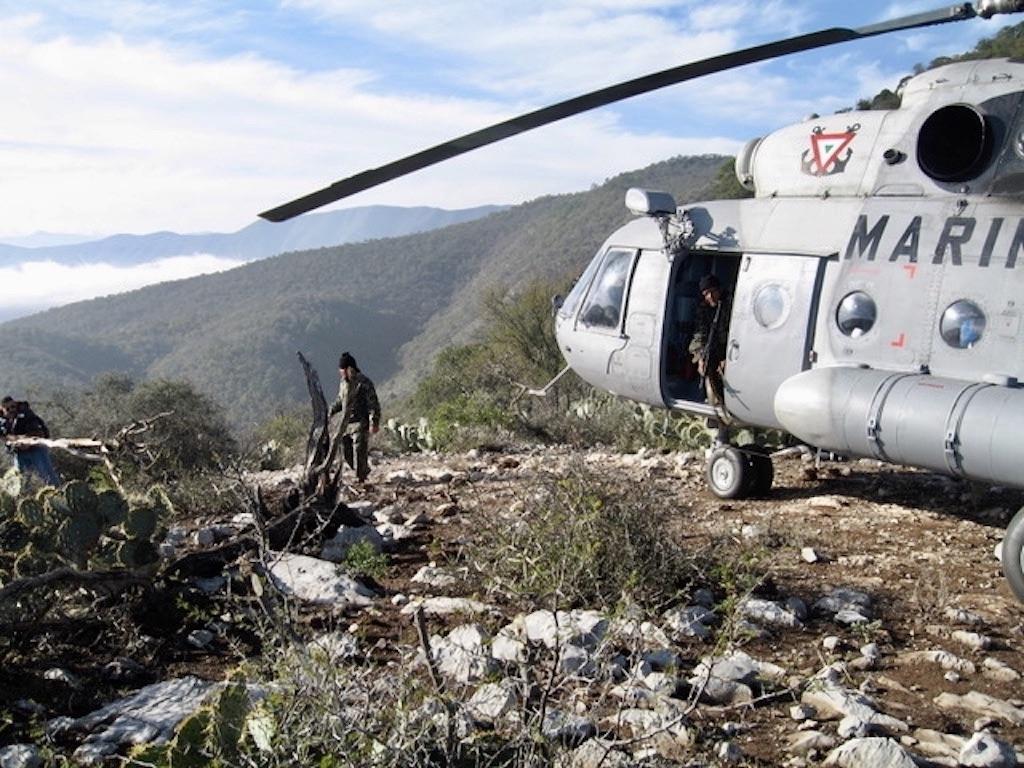
A Mexico Marines helicopter transported investigators to the site of the accident.
In December 2012, the famous Latina singer Jenni Rivera and her traveling companions died in an aircraft crash high in the Sierra Madre Oriental mountains south of Monterrey, Mexico.
To her millions of fans in Mexico and in Latino communities in the U.S., she was as loved and admired as any rock or country star. Everyone wanted to know what happened, and they must have been disappointed and saddened when the investigation failed to find the cause.
The Direccion General de Aeronautica Civil (DGAC) of Mexico developed several theories about the accident, but in the end, there was not enough hard evidence to support any of them conclusively. The DGAC could never pin down the airworthiness state of the Learjet 25, and they could not determine what errors, if any, the crew made.
The investigation raised two major issues, neither one of which was resolved. The first was the cause of the Learjet suddenly plummeting from its cruise altitude to its destruction. The second centered around why a was a U.S.-registered business jet was flying an obviously illegal charter in Mexico.
The Learjet’s steep and sudden uncontrolled descent was eerily similar to a series of early-model Learjet crashes that took place in the early 1980s. Some of those flights probably experienced Mach tuck, a pitch-down tendency in the transonic speed range. The slim facts available in the Rivera case did not quite match those cases, but a closer look is merited. Those old cases could provide insight into what happened to the 43-year-old accident aircraft.
The Learjet 25, registration N345MC, departed Monterrey International Airport (MTY), Mexico, at 3:15 a.m. on Dec. 9, 2012. There were two pilots and five passengers on board, and its destination was Toluca International Airport (TLC). Toluca is 39 mi. south of Mexico City. The estimated time en route was 1 hr., and the planned cruise altitude was 37,0000 ft.
The pilots checked in with Monterrey Departure control a few minutes after takeoff. They were in radar contact. They turned south to join their planned flight route. At 0324 they switched to Monterrey Center and reported passing 15,000 ft. and climbing to FL370. About 8 min. later, at an altitude of 28,700 ft., radar returns showed the jet slowing to 360 kt. from 400 kt. Ten seconds later, it disappeared from the radar scope. There were no further communications from the pilots.
Search-and-rescue efforts began. At 4:20 p.m., the wreckage was found at a place called Rancho el Tejocote in the municipality of Iturbide, Nuevo León state. The location was at an elevation of 5,766 ft. in mountainous terrain. The jet had struck solid rock at an approximate angle of 89 deg. and at a speed in excess of its maximum operating speed.
Parties To The Investigation
As the U.S. was the country of manufacture and registration of the aircraft, the NTSB was authorized to participate in the accident investigation. An FAA inspector and a Learjet expert from Bombardier joined the team. When the U.S. advisors arrived, they were briefed by the DGAC on what it had learned.
Weather conditions at the Monterrey airport and along the route of flight were mild and presented no obvious basis of concern. Skies were clear to partly cloudy, and there were no storms, icing conditions or turbulence for the pilots to contend with.
Rivera had led a turbulent life, with some broken relationships and a recent divorce. Some threats had been made against her. However, there were no credible reasons to think that someone would want to sabotage the aircraft.
The two main theories of the accident quickly became either pilot error or mechanical failure. There was concern about the flight crew because the captain was well beyond normal retirement age and the co-pilot was young and unqualified on the Learjet.
The DGAC quickly retrieved certificate information about the two pilots. The captain had an FAA commercial pilot (foreign-based) certificate that had been issued in 2010. He also had a DGAC commercial pilot certificate. The captain was 78 and had logged 22,610 flight hr. He had 71 hr. on the type in the previous 90 days, his most recent training was satisfactory and he had no significant health issues. He had more than 12 hr. of rest at a local hotel before the accident flight.
The co-pilot was 21 and had graduated from Space Coast Aviation School in Merritt Island, Florida, in May 2012, several months before the accident. He had an FAA commercial and instrument certificate but no type ratings and no Mexican certificates. Flight plan information showed he had flown 67 hr. in the Learjet in Mexico. He had stayed in the same hotel as the captain.
To learn more about the captain’s background and recent activities, DGAC investigators interviewed his brother, two of his sons, the hotel receptionist, the fixed-base operator traffic agent and the ramp serviceman who helped board the jet and marshal it out.
The captain’s brother was 59 and an experienced pilot. He flew with the captain many times and said he was an excellent, technically good pilot who was strict about checklists and standard operating procedures. He said the captain was in good health.
Safety investigators interview two sons of the captain and delve deeper into the history of the Learjet 25, in Part 2 of this article.





